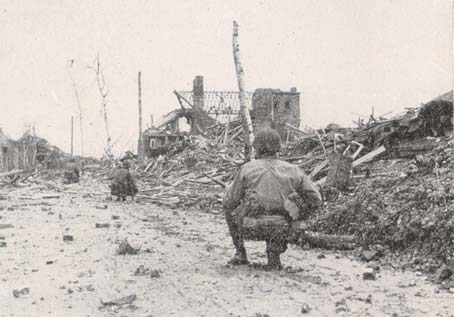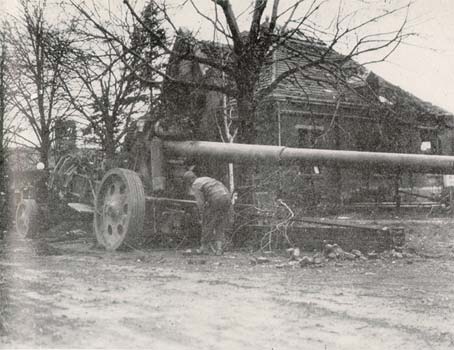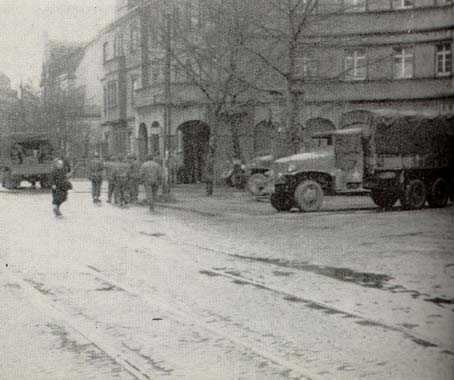| |
From the Roer River to the
Rhine River
February 23 to March 22, 1945
We continue the chronicle of the 35th Division in World
War II with the advantage of 50 years of retrospect with access
now to facts about which we could only speculate when the
events happened back in 1945.
The Battle of the Ardennes was declared
officially over on January 28, 1945 with the Germans under
steady pressure slowly withdrawing toward the Rhine River,
Masters always of skillful delaying actions. Hitler had pulled
the entire German Sixth Panzer Army out of the Ardennes and
had sent them across Germany to bolster his eastern front
against the Russians. This left huge gaps in his defensive
lines along the western front which had to be closed as the
remaining units had to spread out in thinner lines leaving
the German defenses disastrously weak and short of reserves,
both infantry and armor. The allies returned to their Rhineland
campaign which had been interrupted by von Runstedt’s
unsuccessful offensive.
The 35th Division, after its brief sojourn with the Seventh
U.S. Army in the Vosge Mountains was once again in the front
lines North of the Ardennes, this time about seven miles inside
of the German border with The Netherlands, along the West
edge of the Wurm River and along the flooded Roer River, and
about 12 miles North of the Town of Julich.

The 35th Division scouts in vicinity
of Heinsberg, Germany.
German outposts, snipers’ nests, and artillery observers
were scattered in the level plains in front of us, protected
by numerous hidden mine fields and booby traps. February’s
unseasonal warming thaw was making the ground into soggy and
muddy fields. In the skies above aerial flights daily passed
overhead toward the East and back, targeting industrial areas
and strategic targets with their lethal loads, and occasionally
Luftwaffe planes passed reconnoitering and sometimes strafing.
More frequent were the German “buzz” bombs which
“put-putted” overhead in erratic patterns, sometimes
cutting their motors and plunging to earth with huge explosions.
With the moderation of the weather came encouraging reports
from the eastern front of the steady progress of the powerful
Russian armies ever closer to the German borders. From the
“other war” halfway around the world came news
from the Philippines and McArthur’s relentless island
hopping campaign bringing the war ever closer to the Japanese
Islands. The feeling of victory was in the air and the G.I.’s
sensed it.
The Allied plan in Europe for February, 1945 was for a general
offensive all along the front, from Nijmegen in the North
to the Saar area in the South, to drive the Germans back across
the Rhine River. The main effort was to be in the North and
we were right in the center of this sector. It would be made
by Field Marshall Montgomery’s 21st Army group, consisting
of the 1st Canadian Army on the left, with several British
units attached, and the U.S. Ninth Army on the right. The
35th Division was in the Ninth Army, with the XVI Corps ,
on the left of Ninth Army’s front. Gen. Anderson was
the Corps Commander and we were with the 9th Armored Division,
backed by the 79th Division and for a short while also the
British 7th Armored Division. Gen. Simpson’s Ninth Army
had a total of 11 U.S. Divisions, 303,243 men and over 2,000
tanks spread about 50 miles along the Roer River from Venlo
South to Krauthausen which is some 20 miles West of Cologne.

Captured German Gun near Borth,
Germany.
In Operation Veritable the Canadians were to jump off on
February 6, 1945, attacking South and southeasterly along
the West side of the Rhine River to link up with the northward
attacking Americans who were to attack two days later, and
put huge pincers around the German Roer River defenders. The
Canadians hope for a quick armored breakthrough which, however,
never materialized and the attack turned into a slow slugging
match with a stubborn, reinforced German defense. The American
attack had to be postponed when the Germans opened the sluices
to the Roer River dams including the huge Schwammenual Dam,
raising the level of the Roer River by four feet, a current
of 10 miles per hour and widened the river from a narrow 90
feet to 300 yards and in some places 1½ miles. It wasn’t
until February 23rd that we could move.
During those two extra weeks, Ninth Army built up further
supplies, units were built up to full strength, 46,000 tons
of ammunition were amassed and 3 million gallons of gasoline
so our tanks would not run short as they had done at Nancy.
Our troops had additional training in river crossing techniques,
mine and booby traps, attack of concrete fortifications such
as were in the Siegfried Line just across the Roer River.
Unit commanders also were on flights in light observation
planes to observe and study the areas over which we were soon
to attack. Replacements and men returning from the hospitals
brought us up to full strength and we were allowed to give
passes to our men to visit nearby Brussels. We were ready!
In addition to our XVI Corps, other American Division in
Ninth Army included the 2nd, 3rd and 5th Armored Divisions,
and the 8th, 29th, 30th, 83rd, 95th, 99th, and 104th Infantry
Divisions. Intelligence reported that we outnumbered German
defenders perhaps 5 to 1, that German units were way under-strength,
that there were too few German soldiers to defend the entire
West wall fortifications and that we would likely experience
heavy defense centered around the many villages and towns.
To each division in our sector a tank battalion armed with
Sherman tanks and 75mm guns was attached. They were manned
by colored troops in some instances and led by white officers.
We received the 784th Tank Battalion which soon proved itself
as an effective, courageous, and dependable unit which earned
the respect and admiration of the infantrymen who worked together
well with the tankers.
On February 23, 1945, a day before the flooding had fully
subsided, over 2,000 guns opened up a terrific barrage across
Ninth Army front, beginning at 0245 hours, with one gun for
every two yards of front. Forty-five minutes later our 320th
Infantry jumped off along with five other divisions. Our Santa
Fe men crossed the Wurm River and swept the Germans before
them closing on the Roer River. The other divisions all crossed
the Roer River in massive attacks. The 134th Infantry sent
patrols into Hilfarth while part of the division feinted a
river crossing at another location to confuse the Germans.
On February 25th, the 134th attacked and took Hilfarth along
with a small bridge across the Roer River, still usable. The
137th Infantry crossed the Roer on the right and took Doveren
and attacked northeast. The 320th Infantry crossed the Roer
using a bridge in the 84th Division sector to our right. Shortly
the 35th Division was cutting through the Siegfried Line and
extending its bridgehead, taking 23 German towns in two days.

German street scene
With the 84th Division on our right, only Germans were on
our exposed left flank. Straight North ran the Siegfried Line
with its fortifications for some 20 miles. Somewhere beyond
was the Canadian Army attacking South. To the North were at
least four German Divisions, including the 183rd Volksgrenadiers,
Elm’s 338th, the 176th Division and parts of the First
Parachute Army, some of these along the Roer River facing
West. The Santa Fe Division was poised for a breakthrough
reminiscent of St. Lo. Twenty-three miles North of us were
The Netherlands and the Dutch city of Venlo, on the East bank
of the Roer River. Gen. Paul Baade grhtmed the situation and
the opportunity. On February 28th, he created Tank Force Byrne,
named after the commander of the 320th Infantry, and including
that regiment, two field artillery battalions, the 216th and
275th, the 784th Tank Battalion, and companies from the 654th
Tank Destroyer Battalion, the 60th Engineers and the 110th
Medics. The tank force moved North behind the German lines
with Dough boys riding the tanks, engineers blowing up pillboxes
along the way. Baade asked and received permission from Gen.
Anderson to cross into the British sector and on March 2nd
we took Venlo with some sharp fighting in town. Once again,
as in the Third Army blitz across France, the Sante Fe men
were cheered by a local population as the weary but deliriously
happy Dutch people by the thousands poured out into the streets
of Venlo, many dressed in orange, to greet their liberators
after more than four years of Nazi occupation.
The 35th Reconnaissance Troop took Herkenbosch and Roermond,
and a battalion of the 134th Infantry continued North and
on the next day, against sharp opposition, took the Town of
Geldern, 13 miles to the North, and made contact with the
British forces moving in from the North.
Meanwhile, Task Force Byrne wheeled northeastwardly and
with full power charged off toward Wesel on the Rhine, some
30 miles away, shooting up the country side, setting fires
to haystacks and some houses and battling groups of Germans
along the way, fighting from village to village. Straelen
was taken, also Sevelen, and a score of other smaller villages.
The 137th Infantry also operating as a Task Force “Murray”
moved on the right, coordinating with a task force from the
8th Armored Division, and took Lintfort and then Rheinberg
in some of the sharpest fighting, advancing through an area
they called “88" alley. The Germans were now throwing
all of their ammunition at the Americans as they retreated
into a 5 by 8 mile pocket defending the approaches to the
two Rhine River bridges which crossed into Wesel. The 35th
Division drive determined to cut off this last pocket of enemy
resistance West of the Rhine River, hoping to seize the remaining
bridges. Canadians were pinching in from the south and southeast.
Bitter opposition slowed Tank Force Byrne which still took
Huck and Drupt and were relieved by the 134th Infantry moving
through Kamp and Drupt and taking Borth, Buderich and finally
Fort Blucher to find that the Jerries had blown the bridges
before they could get there. The British 52nd Division relieved
the 35th men on March 11th and Operation Grenade was over.
We were at the Rhine, looking across at the Ruhr Valley, the
Pittsburgh of Germany, some 8,000 square miles of factories
and iron and steel producing areas.
In our sixteen days of engagement, we had taken 4,775 prisoners,
suffered lighter casualties than expected. In fact, Ninth
Army had taken only 7,437 battle casualties, of which 1,048
were KIA’s. Another 5,546 were lost from non battle
causes. The entire 9th Army had taken 29,628 prisoners, and
an unknown number of casualties and deaths were inflicted
on the Germans.
On March 8, 1995, the 9th Armored Division in the First Army
had captured the Remagen Bridge South of Cologne over the
Rhine River.
A welcome rest awaited the 35th Division as we were pulled
back from the Rhine River and trucked to an area about eight
miles southeast of Venlo for rest, recuperation and rehabilitation,
replacement of equipment, receiving replacements, cleaning
up, food and rest. Passes were available for non-German cities
and we could prepare for the crossing of the Rhine, and the
taking of the Ruhr. A spirit of optimism began to pervade
the Sante Fe, and yet there was that nagging apprehension.
So near the end of the war and we didn’t want to lose
any more of our buddies. Yet we knew we would because Hitler
was going to sacrifice all of the German people rather than
surrender. The break was to last twelve full days until March
23rd. There would be one more big push......
 Continue
to Page 2 of 5 Continue
to Page 2 of 5
|